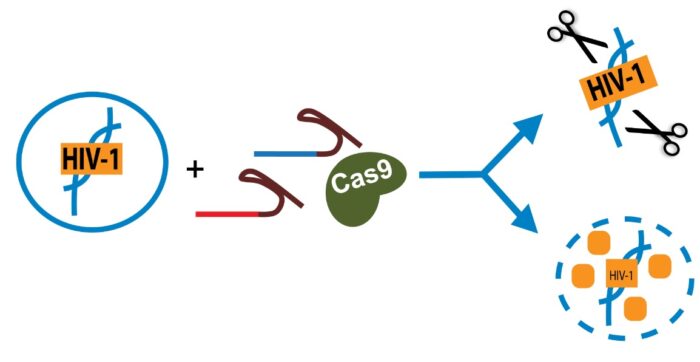Mar 21 2024
Using CRISPR To Treat HIV
 CRISPR has been big scientific news since it was introduced in 2012. The science actually goes back to 1987, but the CRISPR/Cas9 system was patented in 2012, and the developers won the Noble Prize in Chemistry in 2020. The system gives researchers the ability to quickly and cheaply make changes to DNA, by seeking out and matching a desired sequence and then making a cut in the DNA at that location. This can be done to inactivate a specific gene or, using the cells own repair machinery, to insert a gene at that location. This is a massive boon to genetics research but is also a powerful tool of genetic engineering.
CRISPR has been big scientific news since it was introduced in 2012. The science actually goes back to 1987, but the CRISPR/Cas9 system was patented in 2012, and the developers won the Noble Prize in Chemistry in 2020. The system gives researchers the ability to quickly and cheaply make changes to DNA, by seeking out and matching a desired sequence and then making a cut in the DNA at that location. This can be done to inactivate a specific gene or, using the cells own repair machinery, to insert a gene at that location. This is a massive boon to genetics research but is also a powerful tool of genetic engineering.
There is also the potential for CRISPR to be used as a direct therapy in medicine. In 2023 the first regulatory approval for CRISPR as a treatment for a disease was given to treatments for sickle cell disease and thalassemia. These diseases were targeted for a technical reason – you can take bone marrow out of a patient, use CRISPR to alter the genes for hemoglobin, and then put it back in. What’s really tricky about using CRISPR as a medical treatment is not necessarily the genetic change itself, but getting the CRISPR to the correct cells in the body. This requires a vector, and is the most challenging part of using CRISPR as a medical intervention. But if you can bring the cells to the CRISPR that eliminates the problem.
The potential, however, is huge. The obvious targets for CRISPR therapy would be any genetic disease. Mutated genes could be silenced, inactive genes could be activated to compensate for the mutation, or new functional genes could be inserted. CRISPR gene therapy could be a literal cure for genetic diseases.
Recently, however, a team from the University of Amsterdam presented an abstract at a medical conference showing a proof of concept for a different therapeutic use of CRISPR – to treat HIV (the human immunodeficiency virus). HIV is a retrovirus, which means it uses reverse transcriptase to insert its genetic code into the DNA of host cells, in this case immune cells. In this way it hijacks the reproductive machinery of the host cells to make more copies of itself. HIV is insidious because at the same time it also preemptively weakens the host’s immune system. We now have very effective treatments for HIV, and properly treated those infected could live a near normal life expectancy. But HIV is notoriously difficult to cure or eradicate.
Part of the challenge is that HIV can go dormant inside host immune cells. It just sits there, in the host DNA, and can reactivate at any time. Some treatments are geared towards activating these viruses so that they can then be targeted by other drugs, and this helps, but still does not lead to eradication. What the Amsterdam scientists did was use CRISPR/Cas9 to literally cut HIV out of the host cells. They treated three volunteer patients for 48 week, showing that the treatment was safe, with no serious side effects. Of course, this is very preliminary evidence, and the researchers are careful to point out this is a proof-of-concept only. We are still years away from an effective treatment. But this preliminary data is encouraging.
It’s still too early to see what the effect of this treatment was. Again, the real challenge is the vector – getting CRISPR to enough immune cells to make a difference. It’s easy to see how this could become an effective treatment, further reducing the HIV load in an infected patient. But the real goal, and what sets this apart from other HIV treatments, is that this is designed to be a cure. But that means it has to completely eliminate HIV from infected cells, or at least thoroughly enough that it is undetectable. The real test will be, can treated patients stop their HIV medications without running the risk of a recurrence? Again, this will take years of research to find out.
This is a nice proof of concept, and a brilliant use of the CRISPR/Cas9 system. I have been following CRISPR news closely for the last decade, and it really has advanced quickly. I think that is primarily due to the fact that this technology facilitates its own research. The first real appeal of CRISPR was as a tool for genetics research, which includes CRISPR itself. It is cheap and fast, meaning that even small labs around the world can engage in CRISPR research, and the pace of genetics research has increased dramatically. This is a great technological positive feedback loop.
We can likely expect continued advances in the CRISPR technology itself along with basic science genetics research, and increasing medical applications. We are still just at the beginning of this technology. It is also perhaps the one recent technology that I feel is not overhyped.






